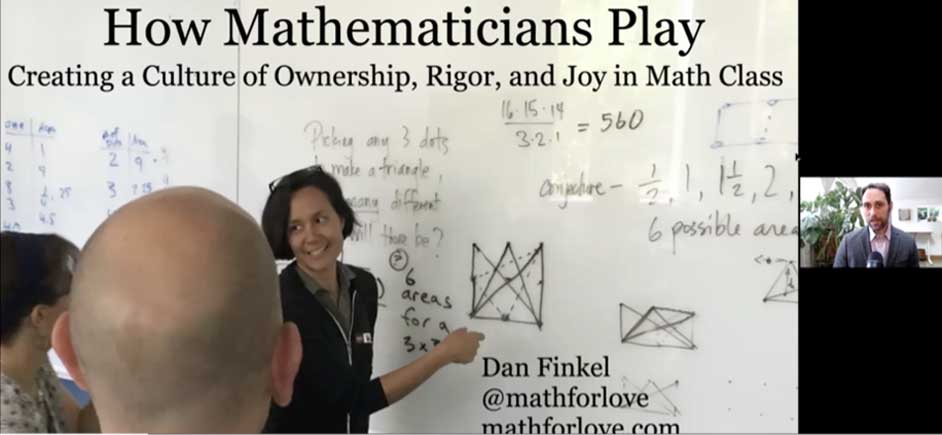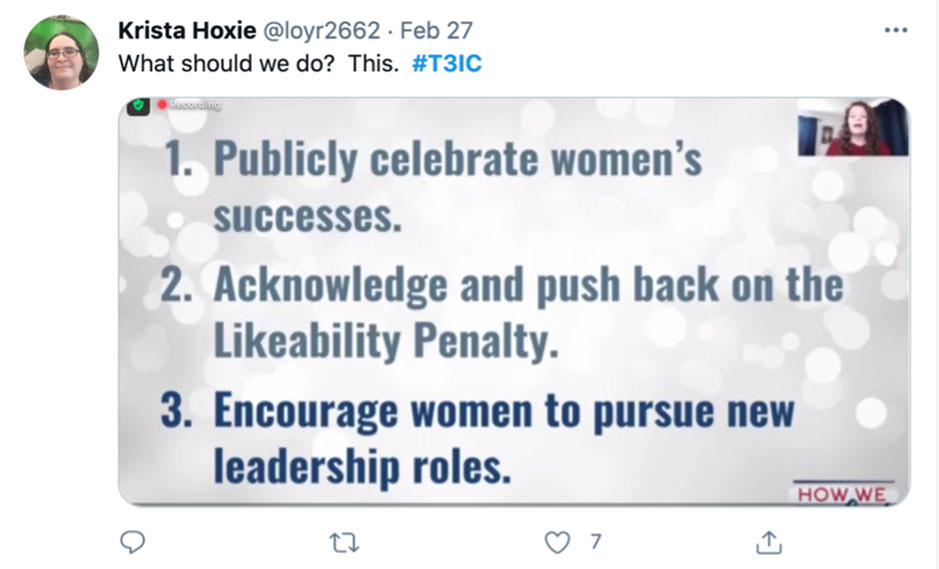My Top Takeaways From T³IC to Encourage, Engage and Empower
When attending a conference, most participants hope to leave inspired, motivated and empowered with strategies and tools to make positive impacts in their classrooms, schools and educational communities. The 2021 T³™ International Conference was appropriately themed, Encourage. Engage. Empower. From the opening keynote with Dan Finkel, Ph.D., to the 7 for7 “Ideas that Inspire,” and everything in between, #T3IC2021 did not disappoint!
Finkel opened the conference by encouraging educators to create a culture of ownership, rigor and joy in their classes. He suggested that we invite students to take ownership by rightly framing their work. Frames that are too thin make it hard for students to focus, while frames that are too thick do not invite students to contribute. An immediate application of appropriate frames can be the implementation of conjectures and counterexamples. By allowing students to state conjectures and ponder counterexamples, we in turn provide space for curiosity, ownership and courage.
Finkel reminded us that answers and facts end learning experiences, while questions and conjectures extend learning experiences. There is power in beginning a learning experience with inquiry rather than answers. Empower your students to play within the appropriate frame while increasing student ownership, rigor and joy.

The conference included many dynamic sessions led by thought-leaders in math, science and STEM education. These sessions provided participants with new strategies and resources for using TI technology to engage students, whether learning in person or virtually.
On the first conference day, John Staley, Ph.D., unpacked the D.U.E.S (see below) to guide teacher choices while teaching STEM with intentionality. The focus of this session was discussing how we might build an equitable culture where more students are empowered to access STEM opportunities and succeed. John empowered participants with actions dedicated to:
- Designing learning environments and opportunities.
- Understanding our students.
- Examining and using data to assess and reflect on teaching and learning.
- Selecting and implementing instructional practices.
Participants were encouraged to consider how the classroom is designed to empower students to see themselves as capable, creative thinkers and doers in STEM. As educators, we must reflect on what implicit biases must be addressed, and recognize and acknowledge what students bring to the class. This helps educators understand their students. In an effort to use data as a reflection tool, it is important for educators to consider how formative assessment is implemented to adjust teaching practices and learning strategies. In order to select and implement these strategies, educators must consider how the instructional practices contribute to developing students’ sense of agency. Staley encouraged participants to implement equitable teaching practices and culturally responsive teaching. This pedagogy ensures that students experience academic success, maintain cultural competence, and challenge the status quo of social order.
California teachers, Randi Munch and Jennifer Waters, shared exciting and innovative ways to utilize TI technology to engage students in distance learning. Rather than simply screen-recording the TI software, we can use animations and other products to make class more interactive. I love the MakeAGif tool that was shared as a way to animate photos and allow students to make observations of moving graphs. Teachers can take screenshots of the emulator and compile them in one file that makes them look like the graphs are changing through motion! Who knew GIFs could come in so handy in a math class?
If teachers are looking for a way to make interactive PDFs, Munch and Waters shared the website TeacherMade, which allows students to draw, highlight, annotate, respond to multiple choice questions, and so much more all on a PDF. Since the conference, I have used this tool numerous times, and I highly recommend it!

Last but not least, the 7 for 7 was absolutely empowering! The speakers focused on very thought-provoking topics that left attendees wanting to make moves. They each shared personal stories that resonated with attendees. Michelle Rinehart gave us action items, like publicly celebrating women’s successes and encouraging women to pursue new leadership roles. These action items highlight how we need to lead and can elevate equity in our field.

The 33rd annual T³IC was an epic event with so many applicable and timely takeaways. After reviewing these, I hope you are encouraged, engaged and empowered to advance STEM education!
About the author: Ariel J. Taylor, Ed.D., is the Director of UTeach Accelerate, a secondary STEM teacher preparation program for degree holders and career changers. Taylor is the Founding Director of The RISE Project 501(c)3, which hosts several youth empowerment events throughout the year, including the EmpowerMENt Conference and RISE On The Road. She became a T³IC Regional Instructor in 2019. Her hobbies include crafting, photography and traveling. You can follow her on Twitter at @DrArielJTaylor.
Tagcloud
Archive
- 2025
- 2024
-
2023
- January (3)
- February (3)
- March (5)
- April (3)
- May (3)
- June (3)
- July (2)
-
August (6)
- 5 Ways to Spruce Up Your Classroom for Back to School
- Day of the Dog: Which Dog Is Roundest?
- Women Who Code: A TI Intern’s Fascinating STEM Journey
- 6 Sensational TI Resources to Jump-Start Your School Year
- 3 Back-to-School Math Activities to Reenergize Your Students
- A New School Year — A New You(Tube)!
- September (2)
- October (3)
- November (1)
- 2022
-
2021
- January (2)
- February (3)
- March (5)
-
April (7)
- Top Tips for Tackling the SAT® with the TI-84 Plus CE
- Monday Night Calculus With Steve Kokoska and Tom Dick
- Which TI Calculator for the SAT® and Why?
- Top Tips From a Math Teacher for Taking the Online AP® Exam
- Celebrate National Robotics Week With Supervised Teardowns
- How To Use the TI-84 Plus Family of Graphing Calculators To Succeed on the ACT®
- AP® Statistics: 6 Math Functions You Must Know for the TI-84 Plus
- May (1)
- June (3)
- July (2)
- August (5)
- September (2)
-
October (4)
- Transformation Graphing — the Families of Functions Modular Video Series to the Rescue!
- Top 3 Halloween-Themed Classroom Activities
- In Honor of National Chemistry Week, 5 “Organic” Ways to Incorporate TI Technology Into Chemistry Class
- 5 Spook-tacular Ways to Bring the Halloween “Spirits” Into Your Classroom
- November (4)
- December (1)
-
2020
- January (2)
- February (1)
- March (3)
- April (1)
- May (2)
- July (1)
- August (2)
- September (3)
-
October (7)
- Tips for Teachers in the time of COVID-19
- Top 10 Features of TI-84 Plus for Taking the ACT®
- TI Codes Contest Winners Revealed
- Best of Chemistry Activities for the Fall Semester
- Best of Biology Activities for the Fall Semester
- Best of Physics Activities for the Fall Semester
- Best of Middle Grades Science Activities
- November (1)
- December (2)
- 2019
-
2018
- January (1)
- February (5)
- March (4)
- April (5)
- May (4)
- June (4)
- July (4)
- August (4)
- September (5)
-
October (9)
- Art in Chemistry
- Which Texas Instruments (TI) Calculator for the ACT® and Why?
- Meet TI Teacher of the Month: Jessica Kohout
- Innovation in Biology
- Learning With Your Students
- A first-of-its-kind STEM strategy charts path to help educators
- #NCTMregionals Hartford 2018 Recap
- The Math Behind “Going Viral”
- Real-World Applications of Chemistry
-
November (8)
- Testing Tips: Using Calculators on Class Assessments
- Girls in STEM: A Personal Perspective
- 5 Teachers You Should Be Following on Instagram Right Now
- Meet TI Teacher of the Month: Katie England
- End-of-Marking Period Feedback Is a Two-Way Street
- #NCTMregionals Kansas City 2018 Recap
- Slope: It Shouldn’t Just Be a Formula
- Hit a high note exploring the math behind music
- December (5)
- 2017
- 2016
- 2015
